AM2 Motherboards-Part 4: ATI Crossfire Xpress 3200
by Wesley Fink on August 21, 2006 7:00 AM EST- Posted in
- Motherboards
General Performance
With the Memory Controller on the Athlon 64 Processor, Winstone benchmarks are no longer very revealing of motherboard performance. With the same CPU (and the same memory controller on that CPU) both Winstones are tightly clustered. The only deviation from that is that boards that are tweaked for best gaming performance are often near the bottom of a tight range of benchmark performance numbers. The Winstone tests themselves are rapidly becoming dated, and are no longer supported by PC Magazine. While Winstones are still useful in providing real world performance data in CPU testing, we have dropped Winstones from our standard motherboard test suite.
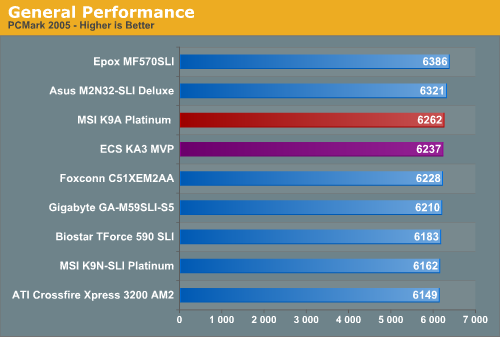
PCMark2005 results for the nine AM2 boards show the Epox 570SLI at the top of the performance chart, followed closely the ASUS M2N32-SLI and the MSI K9A Platinum. The ECS and Foxconn are next in PCM05 performance. These results for the MSI and ASUS are very much in line with other results, as both these boards consistently appear at or near the top of our performance testing.
PCMark05, together with 2 benchmarks that use rendering to test system performance - Cinebench 9.5 and POV-Ray 3.6 - have replaced Winstones for testing general performance. Cinebench 9.5 and POV-RAY 3.6 benchmarks both heavily stress the CPU subsystem while performing graphics modeling and rendering. We utilize the standard benchmark demos in each program along with the default settings. Cinebench 9.5 features two different benchmarks with one test utilizing a single core and the second test using the power of multiple cores to render the benchmark image.
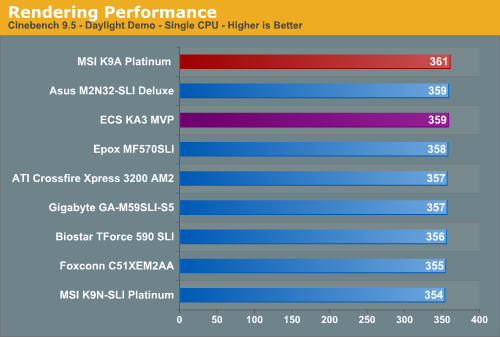
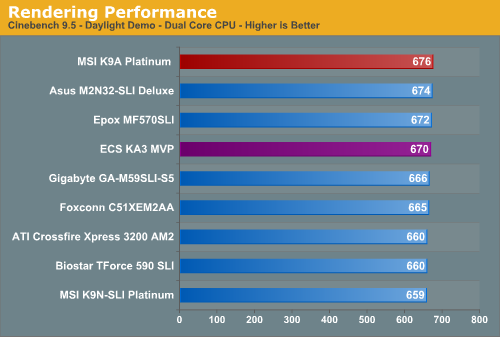
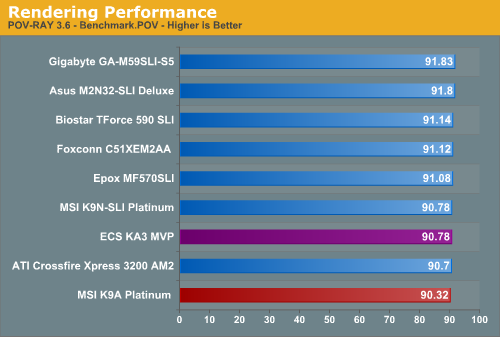
While results are generally close in Cinebench, the MSI K9A, based on the ATI Xpress 3200 chipset, tops both Single-Core and Dual-Core test results. The MSI RD580 is followed closely by the ASUS 590SLI, the ECS KA3 which is also based on the RD580, and the NVIDIA 570SLI based Epox MF570SLI. POV-Ray results are extremely close across DDR2 platforms and show the Gigabyte and ASUS to be the top performers. The ATI chipset boards are reversed in POV-Ray, with all 3 RD580 boards at the bottom of a tightly clustered performance pack.
3D Graphics
The 3DMark benchmarks, published by Futuremark, are probably the most widely quoted gaming performance benchmarks available. While the benchmarks are based on game sequences written by Futuremark to reveal subtle differences in gaming performance, they still have to be considered synthetic benchmarks. They are useful for broad Graphics comparisons, but they are no substitute for benchmarks with real gaming engines that are currently being played.
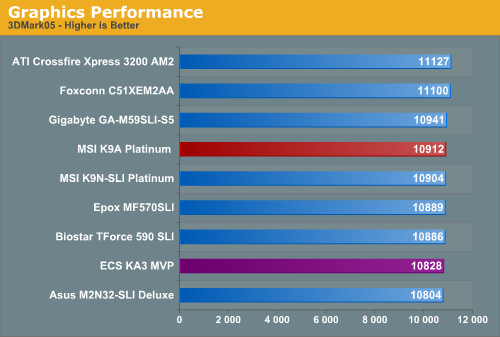
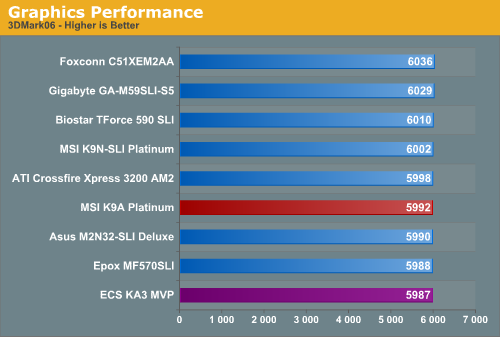
The MSI K9A managed to place in the top of 3DMark05 performance, while the ECS was one of the poorer performers in the AM2 test group. After topping PCMark2005 it was a surprise to see the MSI, ASUS, Epox, and ECS nailing down the bottom of 3DMark06 performance. Results were close, differences were minor, but neither the MSI nor ECS distinguished themselves in this newest 3DMark benchmark.
Encoding
We have found encoding results are not affected by the graphics card used during the encoding benchmarks, which should come as no surprise since theoretically this is to be expected. This is demonstrated again and again by archive test results for AutoGK using an AMD 4000+ processor with a wide assortment of video cards. The performance range of encoding tests over 2 years with the same CPU is just 48.1 to 49.1 - a difference form high to low of just 1.0 frame. Clearly the biggest influence on this encoding benchmark is the CPU used for testing. Because encoding test results vary so little on the same standardized motherboard test platform, they have been dropped from motherboard reviews. Encoding tests are very useful in CPU testing, but they have been shown to be poor motherboard tests - particularly on the AMD platforms with the memory controller on the CPU.
With the Memory Controller on the Athlon 64 Processor, Winstone benchmarks are no longer very revealing of motherboard performance. With the same CPU (and the same memory controller on that CPU) both Winstones are tightly clustered. The only deviation from that is that boards that are tweaked for best gaming performance are often near the bottom of a tight range of benchmark performance numbers. The Winstone tests themselves are rapidly becoming dated, and are no longer supported by PC Magazine. While Winstones are still useful in providing real world performance data in CPU testing, we have dropped Winstones from our standard motherboard test suite.

PCMark2005 results for the nine AM2 boards show the Epox 570SLI at the top of the performance chart, followed closely the ASUS M2N32-SLI and the MSI K9A Platinum. The ECS and Foxconn are next in PCM05 performance. These results for the MSI and ASUS are very much in line with other results, as both these boards consistently appear at or near the top of our performance testing.
PCMark05, together with 2 benchmarks that use rendering to test system performance - Cinebench 9.5 and POV-Ray 3.6 - have replaced Winstones for testing general performance. Cinebench 9.5 and POV-RAY 3.6 benchmarks both heavily stress the CPU subsystem while performing graphics modeling and rendering. We utilize the standard benchmark demos in each program along with the default settings. Cinebench 9.5 features two different benchmarks with one test utilizing a single core and the second test using the power of multiple cores to render the benchmark image.



While results are generally close in Cinebench, the MSI K9A, based on the ATI Xpress 3200 chipset, tops both Single-Core and Dual-Core test results. The MSI RD580 is followed closely by the ASUS 590SLI, the ECS KA3 which is also based on the RD580, and the NVIDIA 570SLI based Epox MF570SLI. POV-Ray results are extremely close across DDR2 platforms and show the Gigabyte and ASUS to be the top performers. The ATI chipset boards are reversed in POV-Ray, with all 3 RD580 boards at the bottom of a tightly clustered performance pack.
3D Graphics
The 3DMark benchmarks, published by Futuremark, are probably the most widely quoted gaming performance benchmarks available. While the benchmarks are based on game sequences written by Futuremark to reveal subtle differences in gaming performance, they still have to be considered synthetic benchmarks. They are useful for broad Graphics comparisons, but they are no substitute for benchmarks with real gaming engines that are currently being played.


The MSI K9A managed to place in the top of 3DMark05 performance, while the ECS was one of the poorer performers in the AM2 test group. After topping PCMark2005 it was a surprise to see the MSI, ASUS, Epox, and ECS nailing down the bottom of 3DMark06 performance. Results were close, differences were minor, but neither the MSI nor ECS distinguished themselves in this newest 3DMark benchmark.
Encoding
We have found encoding results are not affected by the graphics card used during the encoding benchmarks, which should come as no surprise since theoretically this is to be expected. This is demonstrated again and again by archive test results for AutoGK using an AMD 4000+ processor with a wide assortment of video cards. The performance range of encoding tests over 2 years with the same CPU is just 48.1 to 49.1 - a difference form high to low of just 1.0 frame. Clearly the biggest influence on this encoding benchmark is the CPU used for testing. Because encoding test results vary so little on the same standardized motherboard test platform, they have been dropped from motherboard reviews. Encoding tests are very useful in CPU testing, but they have been shown to be poor motherboard tests - particularly on the AMD platforms with the memory controller on the CPU.










28 Comments
View All Comments
mike6099 - Thursday, September 21, 2006 - link
The review does not list the ASUS M2N32-SLI as having raid 5. however, at newegg it lists that it does. does the ASUS M2N32-SLI indeed have raid 5 capability?dougcook - Friday, September 8, 2006 - link
Be careful with the MSI K9A. If you get one, you'll probably want to get a better chipset cooler for it.I bought an MSI K9A board (after reading this review). The 570 chipset seemed about right for me. Everything seemed ok (some things seemed a bit cheap, but nothing really unusual). There were reports about it being incompatible with some memory, so I was careful there and got the good stuff. I got it all installed and it looked like it was running fine...
For one day (until I actually tried to use it).
The first real thing I did was burn a few CDs. In the middle of the 3rd CD, the Northbridge overheated and the machine turned itself off. This happened 2 more times, and then the machine failed to boot at all (even after giving it time to cool off). I wasn't overclocking, and the box had decent ventilation. The CPU's temperature was fine, the GPU's temperature was fine, the case temperature was fine, but the chipset temperature was through the roof. I had to return the motherboard.
This may not happen for everybody, but looking on NewEgg, it seems that this has happened to many other people. The MSI northbridge does not have an adequate heatsink and is likely to burn up. Save the time and get something better. I got the equivalent ABit 570 SLI motherboard, and I've been very happy so far. I hear good things about the ASUS 570 as well.
Stele - Wednesday, August 23, 2006 - link
Great article! If only there were more Xpress 3200 boards on the market now... perhaps Anandtech would do a further roundup when that is the case?Good to see that most motherboard manufacturers are keeping that 24-pin ATX connector well at the edge. So far the only outstanding exception to this practice seems to be EpoX...
As for the 4-pin 12V connector, well, it may not be the best place to be for airflow and cable routing reasons, but that location is actually part of the ATX form factor specifications, which clearly states that the 12V connector should be "next to Voltage Regulator" (ATX Specification v2.2, pg 8). Motherboard designers likely just followed that to make life easier. Specifications aside, it also makes much engineering sense as it keeps traces short - crucial to maintain the quality of power supplied to something as important as the CPU VRM. Besides, airflow considerations are less of an issue with respect to four strands of wire.
IMHO perhaps the one improvement the designers could do while keeping with the spirit of the specifications would be to put the connector on the other side of the VRM, nearer the motherboard edge, though still at the I/O side of the motherboard instead of at the edges nearer the 24-pin ATX connector.
lopri - Wednesday, August 23, 2006 - link
Boy, do I love this article! Thanks to Wesley for this great review. Usually in previous AT motherboard reviews, many difficulties/bugs that end-users experience were often overlooked. (Warm-boot, Cold-boot, Vdroop(?), etc.) I sort of understood it as a result of working with motherboard manufacturers (It's been mentioned that they get BIOS updates on a daily basis), but I used to think AT's motherboard reviews were somewhat different from end-users' experience of retail products.This review feels much realer and it sounded almost like what I went through with a couple of the boards that I bought after reading AT reviews. I'm very glad and grateful, and hope AT keeps this critical viewpoints for future reviews, especially for motherboards.
lop
Le Québécois - Monday, August 21, 2006 - link
When you are talking about the SB600 featuresShouldn't it be: Athlon 64, Athlon 64 X2, Athlon FX, Sempron... To my knowledge Amd have Athlon 64 X2 ;) and even if the FX-60 (939) and the FX-62(AM2) have 2 core AMD still call them simply by FX and not FX X2.
JarredWalton - Monday, August 21, 2006 - link
Edited. Basically, SB600+RD580 supports all current 939/AM2 AMD CPUs. Not sure about SB460, as Wes specifically didn't list dual core and Opteron parts there. I would guess it does, but I will leave that edit to him just to be safe.Furen - Monday, August 21, 2006 - link
=)He just meant that FX X2 doesn't exist. There are A64s X2s and A64 FXes but even the dual-core parts are plain FXes.
mendocinosummit - Monday, August 21, 2006 - link
So, awards were handed out despite the fact that ASUS and other top mobo manus don't have ATI boards yet? Am I to assume that this is the end of the mobo lineup? I would really like to see at least two more boards featuring a ATI chipset; especially since the ECS board will basically be a flop at launch.Gary Key - Monday, August 21, 2006 - link
We also have a few mATX AM2 boards along with a couple of value solutions that we will be reviewing shortly. There is still the upcoming DFI 590SLI AM2 board to review also. :)yyrkoon - Monday, August 21, 2006 - link
Will you guys be testing any of the ABIT boards ? For me personaly, so far, my choice is the ABIT AN9 32x (non fata1ity). I like this board because it offers the SIL 3132 controller, and has an eSATA socket in the I/O section. This is, I'm hoping to use this board with a SATA port multiplier, for some external RAID 5 goodness :)